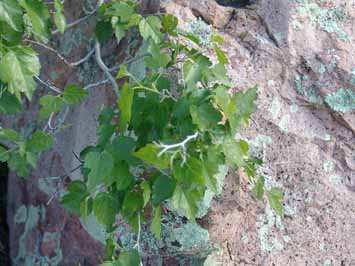
Texas Mulberry (Morus microphylla)
In October 1998, we noticed some clearly deciduous trees, whose autumn foliage was prominent at the base of the northwestern edge of the Notch Ridge (and photographed above). Not until April 2004 did we find time to return to this location to examine the trees more closely, finding that the very large tree in the old photograph was no longer obvious. But we did find a rather smaller, clearly deciduous tree growing out of the base of the ridge rocks (perhaps the smaller tree to the left above?):

Phil Jenkins, staff botanist for the University of Arizona Herbarium, identified the specimens of leaves and inflorescences we collected as Texas Mulberry. In general, Mulberry leaves are toothed, and usually both lobed and not-lobed leaves appear on the same trees (the not-lobed leaves being somewhat heart-shaped). Texas Mulberry leaves are distinctively small, 1-3 inches long. The images below show small leaves in profusion and from various angles (click on each image to enlarge it) -- showing both lobed and not-lobed leaves.
Inconspicuous flowers that appear in March to April bear blackish, fleshy, edible fruits in May to June. The O'otam gathered these fruits, and birds and other animals eat them.
Texas Mulberry is a native plant having affinities less to our lower desert and more to higher parts of our area (it is not listed, for example, in Bowers's Shrubs and Trees of the Southwest Desert, but is present in Elmore's Shrubs and Trees of the Southwest Uplands (see main Trees & Shrubs page for full reference to these books). The latter book's domain concerns "forested slopes from about 4,500 feet", that is the "Upper Sonoran Zone" or "Pinyon-Juniper belt". These trees are common, for example, in the Atacosa Mountains northwest of Nogales, whose peaks top out somewhat above 6000 feet in elevation. So these Texas Mulberries, like our junipers, are occupying microhabitats (north-facing slopes and/or exceptionally moist soils) that mimic current conditions at somewhat higher elevations. They generally appear near water sources in semiarid zones.

